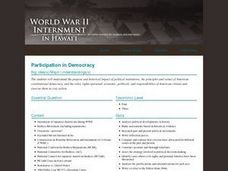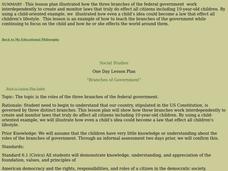Curated OER
The Embodied Presidency
Eighth graders discover details about Thomas Jefferson's life. In this early American history instructional activity, 8th graders view a PowerPoint presentation that outlines some aspects of Jefferson's life. Students research the life...
Curated OER
Marching to the Beat of a Different Drum
High schoolers explore the American dream. In this contemporary music lesson, students analyze the lyrics of songs by Neil Diamond, Bruce Springsteen, and David Massengill. High schoolers create 3-D representations of the American dream...
Curated OER
They're Only Children
Third graders compare how the lives of African American slave children differed from children's lives today. For this analysis of slavery lesson, 3rd graders evaluate and discuss the conditions of slavery in collaborative groups. Using...
Curated OER
Fighting for Democracy, Fighting for Me
Students explore the contributions of African Americans, Japanese Americans, and Mexican Americans in World War II. In this World War II lesson, students research Internet and print sources regarding the treatment of the ethnic groups...
Curated OER
This Land is Ours
Students research and present their findings of the Native American's forced removal in the 19th century. In this Native American lesson plan, students read passages, write and reflect, and look on the internet for evidence of the Native...
Curated OER
Redistricting: How Our Representatives Select Voters
Learners examine the practice of redistricting. In this American politics instructional activity, students read the provided articles "The Gerrymander," and "Reforming the Gerrymander." Learners respond to the provided discussion questions.
Curated OER
Civil Liberties and War Powers: Korematsu v. United States
Eleventh graders compare and contrast Supreme Court decisions dealing with the application of civil rights during times of war, with emphasis on discrimination and detention. Working in groups, 11th graders review cases and analyze how...
Curated OER
Does My Hair Disrupt Your Learning
Students research the laws and policies for school dress codes in their school and others in their state or area and explore what others say about these policies. After research is complete, students divide into two teams to develop...
Curated OER
State of Mind: Inventing the American Identity
Pupils define national identity, explain importance of having national identity, describe America's national identity, work together and formulate class vision of what America's national identity is, identify United States symbols and...
Curated OER
Perspectives of the American Revolutionary War
e purpose of this unit is for students to understand the American Revolutionary War and evaluate different perspectives relative to causes and effects of the war. The concept of perspective is examined in the concept of decision making.
Curated OER
CREATING THE CONSTITUTION
Students engage in a variety of activities aimed at strengthening comprehension of the Constitution. The activities are part of a layered curriculum and students create a portfolio for assessment.
Curated OER
Building Awareness of the Japanese American Wartime Experience
Pupils research the Japanese American World War II Camp Experience. They discuss the experience in the context of civil rights and the Bill of Rights.
National Constitution Center
Abraham Lincoln's Crossroads
History enthusiasts participate in an interactive website that brings Abraham Lincoln to life as he shares his personal experiences between 1854-1864. Scholars listen and read carefully to form their own opinions and discover if they...
Curated OER
The Bill of Rights and You
The right to life, liberty, and the pursuit of happiness. The instructional activity explains what the Bill of Rights is and how it applies to everyday life, like freedom of speech or the right to a jury trial. Young historians complete...
PBS
The Roosevelts: An Intimate History—Snapshot Lessons
The Roosevelt family was one of the most influential and prominent political forces in the 20th century, leaving behind a wide-ranging legacy of conservation, progressivism, and economic growth. Learn more about President Theodore...
The New York Times
A Guide to Political Donations
Voters determine the outcome of elections, but campaign donors can influence the attitudes of those voters. Explore nine examples of donors and the amounts of money they want to contribute, and the legal ways the groups can or cannot...
Curated OER
Children and Family Law
Students examine children's rights and how laws can affect their education and daily life. Through the investigation of various cases, they assess how the best interests of children are either upheld or ignored and how the Constitution...
Curated OER
Participating in Democracy
Students analyze film clips in class. In this democracy lesson plan, students identify the differences between civil liberties, democracy and freedom. Students view a video regarding Japanese internment and answer study questions as well...
Curated OER
The Supremes
Students discuss steps cases go through to reach Supreme Court, examine Bill of Rights, and rank rights in order of importance to them. Students then research Supreme Court case dealing with one of first ten amendments, and write about...
Curated OER
The Gettysburg Address (1863): Defining the American Union
Learners explore the Gettysburg Address. In this U. S. history lesson, students examine Abraham Lincoln's speech and it's themes of freedom, equality, and emancipation.
Curated OER
Branches of Government
Students explore the three branches of government. In this government and U.S. history lesson, students listen to a story about a boy who attempts to sponsor a bill to ban cartoons. Students interview three teachers who each represent...
Curated OER
Alexander Hamilton
In this online interactive history worksheet, students respond to 10 short answer questions about the accomplishments of Alexander Hamilton. Students may check some of their answers on the interactive worksheet.
Curated OER
Forced Assimilation
Students identify ways that a society promotes assimilation and examine areas where it still occurs in our present culture. They assess the value of assimilation.
Pacific University Oregon
Civil Rights: US History
To gain an understanding of the Civil Rights Movement of the 1960s, class members investigate the Jim Crow Laws, the Emancipation Proclamation, the 13th, 14th, and 15th Amendments of the US Constitution, and the 1898 Supreme Court case,...

























